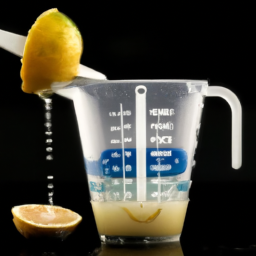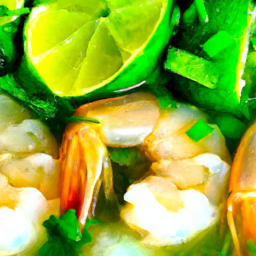As someone who loves fresh orange juice, I often wonder how much juice can be squeezed out of a single orange. While it seems like a straightforward question, there are actually several factors that affect the amount of juice you get, such as the type of orange, how ripe it is, and the juicing method used.
In this article, I will explore these factors and provide tips for getting the most juice out of your oranges, as well as the nutritional value and benefits of drinking orange juice.
First and foremost, it’s important to understand that not all oranges are created equal when it comes to juice yield. Some varieties, such as Valencia oranges, are known for their high juice content, while others, like navel oranges, tend to have less juice. Additionally, the ripeness of the orange can play a role in how much juice it produces. Overripe oranges may be too soft and have reduced juice content, while underripe oranges may be too firm and difficult to juice.
By understanding these factors and choosing the right oranges, you can maximize your juice yield and enjoy the sweet, tangy taste of fresh orange juice.
Key Takeaways
- The amount of juice extracted from an orange can be affected by factors such as its type, maturity, size, ripeness, and temperature.
- Orange varieties with high juice content include Valencia, while navel oranges have less juice.
- To maximize juice extraction, it is recommended to cut the orange in half, use a citrus reamer or juicer, and roll the orange on a hard surface.
- Orange peels can be used to make zest or tea, while orange juice is a good source of vitamin C and can be stored in the refrigerator or freezer for extended shelf life.
Factors that Affect Juice Yield
When juicing an orange, the factors that affect juice yield include its ripeness, temperature, and size. A ripe orange will have more juice than an unripe one, since the fruit’s cells are filled with liquid. However, an overripe orange may have already lost some of its juice and may not yield as much.
Temperature also plays a role, as cold oranges are harder to juice than those at room temperature. The size of the orange affects juice extraction as well, with larger oranges being able to yield more juice than smaller ones.
Apart from these factors, the squeezing techniques used can also affect the amount of juice extracted. Hand-squeezing an orange will yield less juice than using an electric juicer, which can extract more juice from the fruit. Additionally, the way in which the orange is cut and squeezed can affect juice yield.
To maximize juice extraction, cut the orange in half and use a citrus reamer or juicer to press the fruit firmly against the device. With these factors in mind, it’s possible to extract the most juice possible from an orange.
Moving on to the next section, it’s important to note that while these factors can affect juice yield, there is still an average amount of juice that can be expected from a single orange.
Average Juice Yield of an Orange
You can expect an orange to yield a decent amount of refreshing liquid. On average, a medium-sized orange can produce about 1/3 to 1/2 cup of juice. However, the amount of juice you can get from an orange depends on various factors such as the size, the ripeness, and the variety of the orange, as discussed in the previous subtopic.
Juicing techniques can significantly impact the amount of juice extracted from an orange. For instance, using a juicer or citrus press can yield more juice than manual squeezing. Additionally, rolling the orange on a hard surface before cutting it can help break down the pulp and release more juice.
Overall, the juice yield of an orange varies, but with the right juicing techniques, you can get the most out of your oranges. When it comes to getting the most juice out of your oranges, there are a few tips and tricks to keep in mind.
Tips for Getting the Most Juice Out of Your Oranges
To maximize your orange’s refreshing liquid potential, try rolling it on a hard surface before cutting it and using a juicer or citrus press. This technique helps break down the membrane and release more juice. Additionally, using a juicer or citrus press will ensure that you get the most juice out of your orange, without wasting any precious liquid.
Here are some other tips for getting the most juice out of your oranges:
- Use a reamer or juicing equipment designed specifically for citrus fruits.
- Cut the orange in half crosswise, rather than lengthwise, to expose more of the juice sacs.
- Apply gentle pressure when squeezing the orange, being careful not to crush the seeds.
Another way to get the most out of your oranges is to use the leftover peels. Orange peels are rich in essential oils and can be used to make zest, which can be used in cooking and baking. They can also be used to make a fragrant and refreshing tea.
With these tips and tricks, you can enjoy every last drop of juice from your oranges.
When it comes to different varieties of oranges, each has its own unique flavor and texture. From the sweet and juicy Valencia to the tart and tangy Seville, there’s an orange for every taste preference.
Let’s dive deeper into the world of oranges and explore the different varieties available.
Varieties of Oranges
Indulge in a citrus adventure with the diverse and unique varieties of oranges available! Did you know that there are over 600 different types of oranges worldwide? These oranges vary in color, size, and taste.
The most common oranges include navel, Valencia, blood, and Cara Cara oranges. Navel oranges are known for their sweet, slightly tart flavor and are seedless. Valencia oranges, on the other hand, are a bit more tart and are commonly used for juicing. Blood oranges have a unique red flesh and a sweet, yet tangy taste. Lastly, Cara Cara oranges have a pinkish-red flesh and a sweeter taste that is similar to raspberries.
Different colors of oranges indicate different levels of ripeness and can also affect taste preferences. For example, green oranges are unripe and are not suitable for consumption. As oranges ripen, their color changes from green to yellow, then to orange, and finally to a deeper red. The more mature an orange is, the sweeter it will be. Different varieties of oranges also have different levels of acidity, which can affect their taste.
Now that we’ve explored the diverse world of oranges, let’s move on to the nutritional value of orange juice.
Nutritional Value of Orange Juice
The nutritional value of orange juice can’t be underestimated, as it’s packed with essential vitamins and minerals.
However, it’s important to note that consuming whole oranges may provide more nutrients than just drinking the juice. This is because the whole fruit contains fiber, which isn’t present in the juice. Fiber plays an important role in regulating digestion and maintaining a healthy gut.
Despite this, orange juice is still a good source of nutrients, especially vitamin C, which is essential for a strong immune system. Studies have shown that drinking orange juice can help boost the immune system and protect against infections.
Additionally, drinking orange juice can help with nutrient retention. It’s been found that the body is able to absorb more of certain nutrients, such as iron, when consumed with vitamin C-rich foods like orange juice.
Moving on to other uses for orange juice, it can be used in a variety of ways beyond just drinking it.
Other Uses for Orange Juice
When I buy oranges, I always end up with more juice than I can drink. But that’s not necessarily a bad thing, because there are so many other uses for orange juice!
In cooking and baking, orange juice can add a sweet and tangy flavor to marinades, dressings, and sauces. And in cocktails and beverages, orange juice is a key ingredient in classics like mimosas and screwdrivers.
Cooking and Baking
You’ll be amazed at how much juice you can get from just one orange when you use a citrus juicer! With the right juicing technique, you can extract every last drop of juice from the orange.
To get the most juice out of the orange, cut it in half and use a citrus juicer to squeeze the juice out. You can also use a reamer or a fork to extract the juice, but a juicer will give you the most juice and the least amount of pulp.
When it comes to cooking and baking, orange juice can be used as a substitute for a variety of ingredients. For example, you can use orange juice in place of vinegar or lemon juice in salad dressings. You can also use orange juice in marinades for chicken or fish.
When flavor pairing with orange juice, it is important to consider the other ingredients in the recipe. Orange juice pairs well with ingredients like ginger, honey, and cinnamon, but can overpower more delicate flavors like vanilla or mint.
Transitioning into the subsequent section about cocktails and beverages, orange juice is a popular ingredient in many mixed drinks. From classic cocktails like the Screwdriver and the Mimosa, to more modern creations like the Tequila Sunrise and the Orange Crush, orange juice adds a bright and refreshing touch to any beverage.
So, whether you’re cooking, baking, or mixing drinks, orange juice is a versatile ingredient that can add a burst of flavor to any recipe.
Cocktails and Beverages
Indulge in the rich and refreshing taste of orange juice as you explore its use in cocktails and other beverages. Orange juice is a versatile ingredient that can be used in a variety of drinks, from classic mimosas to innovative mocktail recipes.
When it comes to juice pairing, orange juice pairs well with other citrus fruits such as lemon and lime, as well as tropical flavors like pineapple and coconut. Some popular cocktails that use orange juice include the Tequila Sunrise and the Screwdriver.
For those who prefer non-alcoholic drinks, orange juice can be used to make delicious mocktails. A simple recipe is the Orange Creamsicle Mocktail, which combines orange juice, vanilla ice cream, and ginger ale for a creamy and refreshing drink. Another option is the Orange Spritzer, which mixes orange juice, soda water, and a splash of grenadine for a light and fizzy beverage.
With its sweet and tangy flavor, orange juice is a great addition to any beverage menu. Transitioning into the subsequent section about storing orange juice, it’s important to note that while fresh squeezed orange juice is preferred for cocktails and beverages, it can be difficult to squeeze enough juice for large batches. In this case, store-bought orange juice can be used as a substitute. However, it’s important to properly store the juice to maintain its freshness and flavor.
Storing Orange Juice
When it comes to storing orange juice, there are two main options: refrigeration and freezing. Personally, I prefer to refrigerate my orange juice to keep it fresh for a longer period of time.
However, freezing it can also be a good option if you want to store it for a longer period of time.
Refrigeration
Refrigerating oranges can extend their freshness and help preserve the amount of juice they contain. Here are four benefits of refrigeration and the optimal storage temperature for oranges:
-
Longer Shelf Life: When you refrigerate oranges, they can last up to two weeks longer than if stored at room temperature. This is because cooler temperatures slow down the natural ripening process of the fruit.
-
Retains Nutrients: Oranges are a great source of vitamin C, folate, and potassium. Refrigeration helps to preserve these nutrients, making sure you get the most out of your fruit.
-
Prevents Mold Growth: Oranges are prone to mold growth, especially when stored in warm and humid environments. Refrigeration helps to prevent this by creating a dry environment that is not suitable for mold growth.
-
Optimal Temperature: The optimal temperature for storing oranges in the refrigerator is between 35-45 degrees Fahrenheit. This temperature range helps to slow down the natural ripening process of the fruit and preserve its quality.
When it comes to preserving the freshness of oranges, refrigeration is just one option. The next step is freezing, which can also help extend the shelf life of your oranges.
Freezing
You can easily extend the life of your oranges by freezing them, which will make you feel relieved knowing that you won’t have to throw them away anytime soon. Freezing is a great way to preserve the freshness of your oranges, especially if you have too many to consume within a short period of time. When done correctly, freezing can help maintain the quality and flavor of your oranges for up to 6 months.
To freeze your oranges, start by washing them thoroughly and drying them with a clean towel. You can then choose to freeze them whole or sliced into wedges. Place the oranges in a plastic freezer bag, making sure to remove as much air as possible before sealing the bag. Label the bag with the date and store it in the freezer. When you’re ready to use your frozen oranges, simply thaw them in the refrigerator overnight. Frozen oranges can be used in smoothies, juices, or even as a healthy snack.
When it comes to juicing, choosing the best oranges is crucial in getting the most juice out of them.
How to Choose the Best Oranges for Juicing
When it comes to making fresh orange juice, choosing the right oranges is key to achieving a delicious and flavorful result.
In my experience, there are a few important factors to consider when selecting oranges for juicing. These include the seasonal availability of the fruit, as well as its appearance and smell, and the ripeness and firmness of the fruit.
By taking these factors into account, you can ensure that you choose the best oranges for juicing and create a delicious and refreshing beverage that’s perfect for any time of day.
Seasonal Availability
During certain times of the year, oranges may be more readily accessible than at other times. In general, orange trees produce fruit during the winter months, making oranges a seasonal fruit. This means that during this time, oranges are more abundant and cheaper, making them a great option for those who love to make fresh orange juice.
If you’re interested in making recipes using fresh oranges, this is definitely the time to stock up on them. However, popular orange juice brands often use oranges from multiple locations to ensure a year-round supply. This means that even if fresh oranges are not in season in your area, you can still enjoy orange juice any time of the year.
When choosing oranges for juicing, appearance and smell are also important factors to consider.
Appearance and Smell
Now that we’ve discussed the seasonal availability of oranges, let’s take a closer look at their appearance and smell.
When choosing oranges for juice extraction, it’s important to select fruits that are ripe and juicy. The appearance of an orange can give you a good indication of its ripeness. A ripe orange should have a bright orange color, and it should feel heavy for its size. A dull, pale-colored orange may be overripe or underripe, and it may not yield as much juice as a perfectly ripe orange.
In addition to appearance, smell is also an important factor when selecting oranges for juice extraction. A ripe orange should have a sweet, citrusy aroma. If an orange has a musty or fermented smell, it may be past its prime.
Once you’ve selected your oranges, it’s time to analyze their taste and juice content.
Moving on to the next subtopic, ripeness and firmness are two additional factors to consider when selecting oranges for juice extraction.
Ripeness and Firmness
To ensure the best juicing experience, you’ll want to pay attention to the ripeness and firmness of the oranges you choose. Ripeness assessment is critical in determining the amount of juice you can extract from an orange. An underripe orange will not yield much juice, while an overripe orange may be too soft and difficult to juice.
When assessing ripeness, look for oranges that are heavy for their size and have a consistent color. Avoid oranges with soft spots or blemishes, as these may indicate decay. Firmness is also important in determining juiciness. A firm orange will typically have more juice than a soft one. To extract the most juice possible, try rolling the orange on a countertop before juicing, or microwave it for a few seconds to make it easier to juice.
As you consider the ripeness and firmness of your oranges, keep in mind the benefits of drinking orange juice. Drinking a glass of fresh-squeezed orange juice each day can provide a significant boost of vitamin C and other essential nutrients, supporting your immune system and overall health.
Benefits of Drinking Orange Juice
Drinking orange juice is a great way to boost your immune system. One glass contains over 100% of the recommended daily intake of vitamin C. Vitamin C is a powerful antioxidant that helps to protect cells from damage caused by free radicals. It also plays a crucial role in the production of collagen, a protein that’s essential for healthy skin, hair, and nails.
In addition to its high vitamin C content, orange juice also contains other important nutrients such as potassium, folate, and thiamine. Potassium is essential for maintaining healthy blood pressure levels, while folate is important for the production of red blood cells. Thiamine, on the other hand, is essential for the conversion of food into energy.
Drinking orange juice can provide all of these health benefits and more. It makes it a nutritious addition to any diet.
Frequently Asked Questions
How long does it take for the juice to spoil after squeezing an orange?
If I squeeze an orange, the shelf life of the juice depends on various factors such as temperature, acidity, and preservatives. Proper refrigeration and preserving techniques can extend the juice’s life, but if left unrefrigerated, it can spoil within a few hours.
Can you freeze fresh orange juice for later use?
Yes, you can freeze fresh orange juice for later use. To ensure flavor preservation, it’s best to freeze the juice in airtight containers or freezer bags. However, it’s important to note that freezing can alter the texture and taste of the juice.
Is it better to juice oranges or eat them whole for maximum health benefits?
I used to think eating oranges was the best way to get all the health benefits, but after researching, I found that juicing has its pros and cons. Juicing can provide more nutrients, but eating the whole fruit gives you more fiber.
How many oranges do you need to make a gallon of orange juice?
To make a gallon of orange juice, you can use Orange Juice Concentrate or Orange Juice Powder. The amount needed varies depending on the brand and type. It’s best to check the packaging for specific instructions.
What are some common mistakes people make when juicing oranges?
Squeezing technique and choosing ripe oranges are crucial when juicing. Common mistakes include not applying enough pressure and using unripe fruit. As they say, "you can’t make orange juice from lemons."
Conclusion
Well, folks, I hope you’ve found this article informative and helpful in your quest for the perfect glass of orange juice. As someone who enjoys a good glass of OJ in the morning, I was curious about how much juice I could expect from one orange and what factors could affect the yield.
After doing some research, I discovered that the average juice yield of an orange is around ⅓ cup. However, this can vary based on factors such as the ripeness of the orange, the variety of orange, and the juicing method used.
By following some simple tips, like rolling the orange before juicing and using a citrus juicer, you can maximize your juice yield and get the most out of your oranges.
Not only is orange juice delicious, but it also has a range of nutritional benefits, from being high in vitamin C to potentially reducing the risk of chronic diseases.
And if you find yourself with leftover orange juice, don’t worry – there are plenty of other uses for it, from marinades to cocktails. Just be sure to store it properly in the fridge to maintain its freshness.
Overall, I hope this article has helped you in your orange juice journey, whether you’re a seasoned pro or a newbie to the juicing game. Remember, with the right techniques and a little bit of know-how, you can enjoy a delicious and nutritious glass of orange juice any time of the day. Cheers to that!
Ilana has been a vegan for over 10 years. She originally made the switch for health reasons, but soon found herself becoming more and more passionate about the ethical and environmental implications of a vegan lifestyle. Ilana is the author of The Graceful Kitchen, a blog all about veganism. She loves to cook up delicious and nutritious vegan meals, and share her recipes with others who are interested in leading a cruelty-free life. Ilana is also a strong advocate for using whole foods as the foundation of a healthy diet, and believes that going vegan is one of the best ways to achieve this.










